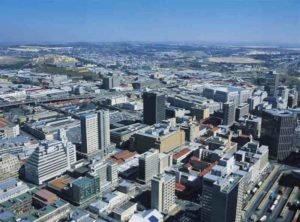According to WorldData.info, costs of living are periodically calculated in nearly representative baskets of consumer goods. But many factors are complicating a worldwide comparison.
2019 index shows that in the world Bermuda, an overseas territory of the United Kingdom in the North Atlantic Ocean is the most expensive country to live in. In a rank of about 102 countries, the United States of American ranked 15th while South Africa ranked 58th in the world.
Also, Numbeo the most popular and largest online database which enables users to share and compare information about the cost of living between cities and countries ranked Singapore to the be the most expensive city in the world to live in. It also rated the cost of living in South Africa to be 38.28% lower than in the US and Rent in South Africa to be 57.18%.

1. Pretoria (Tshwane)
One of the country’s three capital cities, serving as the administrative branch of government stretching from Apies River to the foothills of the Magaliesberg Mountains.
Pretoria is the central part of the Tshwane Metropolitan Municipality which was formed by the amalgamation of several former local authorities including Centurion and Soshaguve. The city houses three top universities in South Africa, University of Pretoria (UP), the Tshwane University of Technology (TUT), and the University of South Africa.
The city also hosts numerous Research foundations. It also boasts of a having a good transport system; railway operated by Metrorail, a bus service by PUTCO, good road network and Wonder boom Airport. Notable Radio stations such as the Impact Radio (103 FM), Jacaranda FM (94.2), Radio Pretoria (104.2) etc.
Lots of natural reserves, Museums, zoological and botanical gardens help serve as center for tourists attractions. The city is a major commercial center and an important industrial center. Its main industries are iron and steelworks, copper casting and manufacture of automobiles, railway carriages and heavy machinery.
2. Johannesburg
Johannesburg is the largest city in South Africa. It is not one of South Africa’s three capital cities but it is the seat of Constitutional Court. Located in the Witwatersrand range of hills, it is the centre of gold and diamond trade.
The city boast of a density of about 170000/km2 and a population of about 56401277 making it the most populous city in South Africa. After the discovery of gold in 1886, the city was interpreted as the modern-day El Dorado due to the large gold deposit found along the Witwatersrand.
Johannesburg is a young city with its public transportation built in its infancy, geared towards private motorists. Johannesburg has two kinds of taxis, metered taxi and minibus taxis. Unlike many cities, metered taxis are not allowed to drive around the city looking for passengers.
The main Airport is the Tambo International Airport (formerly Johannesburg International Airport). The rail system connects central Johannesburg to Soweto, Pretoria and most of the satellite towns along the Witwatersrand.
The two freeways road networks are congested due to mass urbanization. Johannesburg has not traditionally been known as a tourist destination, but the city is a transit point for connecting flights to Cape Town, Durban and the Kruger National Park.
3. Cape Town
The capital (legislative) of South Africa. Founded in 1652, where the parliament of South Africa sits. The city is known for its harbour, and natural setting in the Cape Floristic Region, and for landmarks such as Table Mountain and Cape Point. It is the most multicultural city in the world, reflecting its role as a major destination for immigrants to South Africa.
In 2014, Cape Town was named the best place to visit by both The Daily Telegraph and The New York Times. Cape Town, located on the shore of Table Bay is the oldest urban area in South Africa. Until the Witwatersrand Gold Rush and development of Johannesburg, Cape Town was the largest city in South Africa.
Cape Town is a not a popular international tourist destination in South Africa majorly due to the mild climate, modern infrastructure and natural setting. Although many tourists also visit Cape Town’s beaches, which are popular with local residents. Due to the city’s unique geography, it is possible to visit several different beaches in the same day with a different atmosphere.
Cape Town has a well-developed high system of public universities. Cape town is served by three public universities: the University of Cape Town (UCT), the University of Western Cape(UWC) and the Peninsula University of Technology (CPUT). Both the University of Cape Town and Stellenbosch University, about 50 kilometres from the city bowl are leading universities in South Africa.
Cape Town International Airport, the second-largest airport in South Africa and serves as a major gateway for travellers’ to the Cape region. There is also a Port of Cape Town, a hub for ship transport and a pretty goad Road network.
4. Durban
One of the major centres of tourism in South Africa. Located on the east coast of South Africa on the Natal Bay of the Indian Ocean. Founded in 1835 on the site of Port Natal and was named after Sir Benjamin D’Urban, the governor of the Cape Colony. Durban is the third-most populous city in South Africa after – Johannesburg and Cape Town.
Durban as the busiest port in South Africa. King Shaka International Airport services both domestic and international flights while Durban is known as a port city, the port of Durban, formerly known as the Port of Natal, is one of the few natural harbours between Port Elizabeth and Maputo.
Durban also featured the first operating steam railway in South Africa when the Natal Railway Company started operating a line between the point and the city of Durban in 1860. Reputable tertiary institutions including Varsity College (South Africa), University of South Africa, University of KwaZulu-Natal, Regent Business School etc are found in Durban.
5. Port Elizabeth
Founded in 1820 by the government of the Cape Colony with about 4,000 British colonists, recruited in 1820 in order to strengthen the border region between Cape Colony and the Xhosa. It has a population of over 1.3 million.
Overtaking its next-door neighbouring city East London, Port Elizabeth became the host of the 2010 FIFA World cup. The World Cup was played between 11 June 2010 and 11 July 2010 in which Spain were the eventual champions. The Nelson Mandela Bay stadium hosted eight World Cup games, featuring Chile Switzerland; Slovenia, England; South Korea, Greece; Ivory coast, Portugal; in the First stage, then Uruguay, South Korea in the Group of 16.
A quarter-final between the Netherlands, Brazil was hosted, then for Third Place playoff, Uruguay, Germany were hosted at the stadium. It also boasted of having hosted the 2013 AFCON event.
Port Elizabeth Airport is the fourth busiest airport in South Africa after Johannesburg international airport, King Shaka International Airport in Durban, and Cape Town International Airport. The Port Elizabeth railway station is served and operated by Metrorail. The city’s main bus station is in Market Square.
The Nelson Mandela University was formed by the amalgamation of the University of Port Elizabeth, Port Elizabeth Technikon, and the Port Elizabeth campus of Vista University. It is the largest university in the largest university in the Eastern and Southern Cape, with around 24,000 students in seven faculties.
Reference:
- Wikipedia.org

